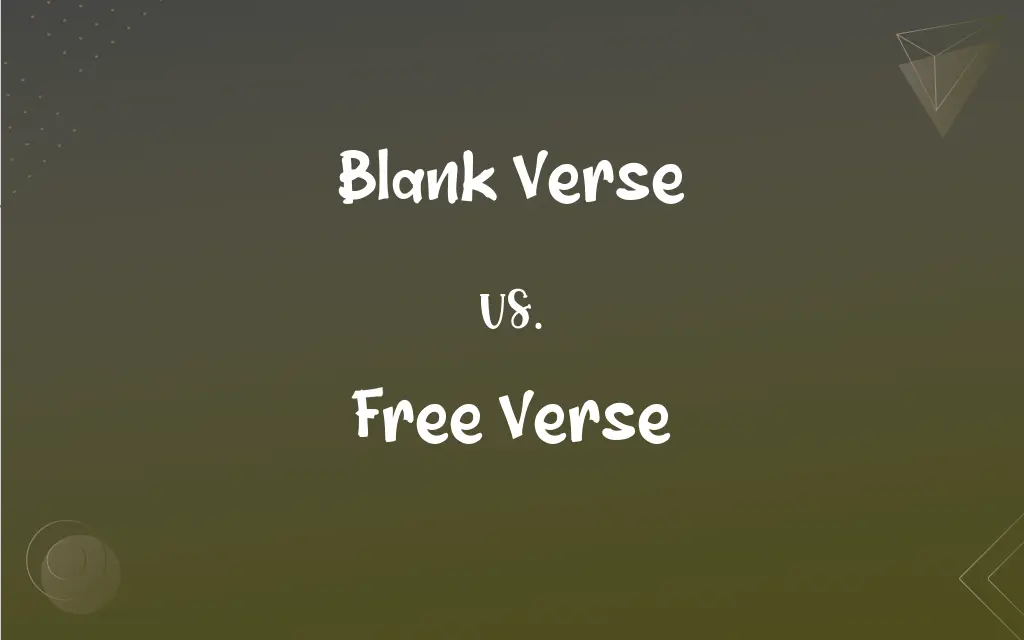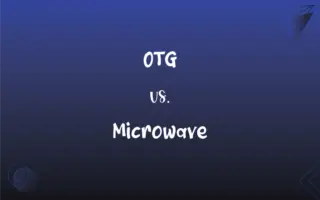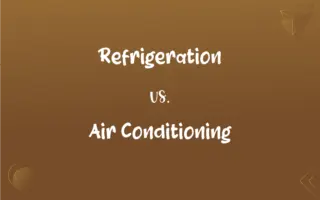Blank Verse vs. Free Verse: What's the Difference?
Edited by Aimie Carlson || By Harlon Moss || Updated on October 13, 2023
Blank verse refers to unrhymed lines of iambic pentameter. Free verse refers to poetry free from fixed metrical patterns and rhyme.

Key Differences
Blank verse is poetry written in unrhymed lines of iambic pentameter, maintaining a specific metrical pattern. In contrast, free verse abandons both rhyme and rhythm, allowing poets an unrestricted form. Both forms have their own unique aesthetic appeal and challenges.
In blank verse, the iambic pentameter provides a rhythmic and metrical structure, rendering a semblance of order and familiarity. Free verse, being devoid of such structures, offers a liberation in expression, and its meaning often derives from natural speech patterns and varied line lengths.
The use of blank verse is prominent in many famous works, such as Shakespeare's plays, marrying structure with expressive possibilities. Conversely, free verse, adopted by poets like Walt Whitman, capitalizes on its freedom, forming a rhythm more akin to conversational speech.
Adept utilization of blank verse requires mastering the iambic pentameter, which demands certain skills in maintaining rhythm without rhyme. On the other hand, free verse, while liberating, requires an ability to create coherence and beauty without relying on conventional structures.
In summation, blank verse and free verse serve as vital, varied avenues for poetic expression. One mandates metric adherence without rhyme, while the other endows poets with unrestricted poetic freedom, both being powerful in conveying profound messages in distinct manners.
ADVERTISEMENT
Comparison Chart
Rhyme
No rhyme is used.
No rhyme is employed.
Rhythm
Adheres to iambic pentameter.
No set rhythm or meter.
Structure
Has a structured metrical form.
Lacks a specific form or structure.
Flexibility
Limited flexibility in form.
Offers maximum flexibility in form.
Famous Exponents
William Shakespeare
Walt Whitman
ADVERTISEMENT
Blank Verse and Free Verse Definitions
Blank Verse
Blank verse utilizes unrhymed iambic pentameter.
To be or not to be, that is the question.
Free Verse
Free verse poetry does not follow rhyme or rhythmic patterns.
I celebrate myself, and sing myself.
Blank Verse
Blank verse is prevalent in Shakespearean works.
Upon the king! Let us our lives, our souls.
Free Verse
Free verse allows for a free-flowing, unrestricted poetic form.
A noiseless patient spider, I mark’d where on a little promontory.
Blank Verse
Blank verse combines metric order without utilizing rhyme.
That patient merit of the unworthy takes.
Free Verse
Free verse is often utilized for its expressive freedoms.
I mind how once we lay such a transparent summer morning.
Blank Verse
Blank verse provides rhythmic structure without employing rhyme.
But, soft! what light through yonder window breaks?
Free Verse
Free verse isn’t bound by conventional poetic structures.
And now it seems to me the beautiful uncut hair of graves.
Blank Verse
Blank verse allows structured poetic exploration.
It is the east, and Juliet is the sun.
Free Verse
Free verse draws heavily from natural speech patterns.
The spotted hawk swoops by and accuses me.
FAQs
Who is a famous writer known for using blank verse?
William Shakespeare is renowned for his extensive use of blank verse.
What is blank verse?
Blank verse is poetry written in unrhymed iambic pentameter.
What characterizes free verse?
Free verse is poetry without fixed rhyme or meter, offering poets complete creative freedom.
Can free verse employ rhyme if the poet desires?
Yes, while it's typically unrhymed, free verse can incorporate rhyme if it aligns with the poet’s intention.
Is blank verse completely devoid of rhyme?
Yes, blank verse uses a metric pattern but does not employ rhyme.
Are there certain eras that favored blank verse?
Yes, for example, the Elizabethan era, exemplified by Shakespeare's works, heavily utilized blank verse.
What kind of auditory experience does free verse create?
Free verse can create a varied and unpredictable auditory experience, often mirroring natural speech.
How does free verse influence the pacing of a poem?
Free verse allows for varied pacing and natural, conversational progression within the poem.
Are there specific themes better suited to blank verse?
Blank verse is versatile but is often chosen for dramatic or exploratory themes due to its rhythmic but unrhymed structure.
What kind of themes often feature in free verse?
Free verse can accommodate any theme but is often favored for personal, introspective, or observational themes due to its flexibility.
Can blank verse and free verse be used together in a poem?
Yes, a poet may choose to combine blank and free verse to explore different rhythmic and expressive possibilities within a single work.
Who popularized free verse in their writings?
Walt Whitman is often associated with popularizing free verse.
Can blank verse be identified with a specific structure?
Yes, blank verse is structured, utilizing unrhymed iambic pentameter.
Why might a poet choose blank verse?
A poet might choose blank verse to combine structured rhythm with flexible expressive potential.
Why might free verse be a poet’s choice?
A poet might choose free verse to freely express ideas without the constraints of traditional poetic forms.
How does blank verse impact the auditory experience of a poem?
Blank verse provides a subtle, rhythmic experience without the overtly patterned sound of rhyme.
Can blank verse be used in all poetic forms?
While adaptable, blank verse may not suit all poetic forms, especially those with fixed rhyme schemes.
Is free verse a modern poetic form?
While not exclusive to modern poetry, free verse became particularly prominent and favored in the 20th and 21st centuries.
How does blank verse contribute to the flow of a poem?
Blank verse offers a steady, rhythmic flow without the predictability of rhyme.
Is free verse structured in terms of rhythm and rhyme?
No, free verse lacks a fixed rhythmic pattern and doesn’t adhere to rhyme schemes.
About Author
Written by
Harlon MossHarlon is a seasoned quality moderator and accomplished content writer for Difference Wiki. An alumnus of the prestigious University of California, he earned his degree in Computer Science. Leveraging his academic background, Harlon brings a meticulous and informed perspective to his work, ensuring content accuracy and excellence.
Edited by
Aimie CarlsonAimie Carlson, holding a master's degree in English literature, is a fervent English language enthusiast. She lends her writing talents to Difference Wiki, a prominent website that specializes in comparisons, offering readers insightful analyses that both captivate and inform.































































